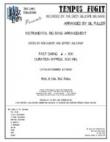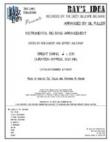TIN TIN DEO [DOWNLOAD]
Recorded by James Moody and the Gil Fuller Orchestra
Arranged by Gil Fuller, Prepared by Dylan Canterbury, Rob DuBoff, and Jeffrey Sultanof

Cat #: JLP-7315-DL
$75.00This product is available for immediate download after purchase.
Questions?
Please call +1-518-587-1102 or email us.
Edition: Jazz Big Band Arrangement
Description: Latin/Swing - Difficult
Publisher: Jazz Lines Publications
Although "Tin Tin Deo" is usually associated with trumpeter Dizzy Gillespie, it was actually co-composed by Gillespie's original arranging partner Gil Fuller and conguero Luciano "Chano" Pozo. This version, arranged by Fuller, was originally intended to feature Gillespie with the Monterey Jazz Festival Orchestra, but ended up being a feature for flautist James Moody on Fuller's 1965 album "Night Flight."
The arrangement starts off with a bombastic half-time introduction before the usual brighter Latin tempo begins at bar 5. Moody enters with the melody at bar 11, with the saxophones and trombones providing some gently pulsing background riffs. The bombast returns at bar 43, where the trumpets take over the melody and the rhythm section shifts to a swing feel. A strong lead trumpet player is an absolute necessity for this portion of the arrangement.
A brief interlude at bar 59 sets up the soloist, who is accompanied by the same background riffs that accompanied the melody. It is important for the ensemble to appropriately adjust their volume level so as to not overwhelm the soloist. The melody is never re-stated, as the arrangement opts to end with a fade out with the soloist improvising over the ensemble's introductory riff.
The original version of this arrangement was written for standard big band instrumentation with three French horn players. We have included an alternate 4th trumpet part as well as an optional 5th trumpet and 4th trombone part if you want to play it with your ensemble but do not have access to French horn players. We have also included two separate soloist parts: a trumpet part (to reflect who the arrangement was originally written for) and a flute part (to reflect how it ended up being recorded). We hope you enjoy playing this chart as much as we enjoyed preparing it for you!
Solo Trumpet or Flute
2 Alto Saxophones
2 Tenor Saxophones
Baritone Saxophone
4 Trumpets
3 Horns in F
3 Trombones
Guitar
Piano
Bass
Drums
Alternate Trumpet 4 (Used in Place of Horn 1)
Trumpet 5 (Optional Alternate Part for Horn 2)
Trombone 4 (Optional Alternate Part for Horn 3)
Trombone 1: Bb4
Alt Trombone 4: Optional E5








